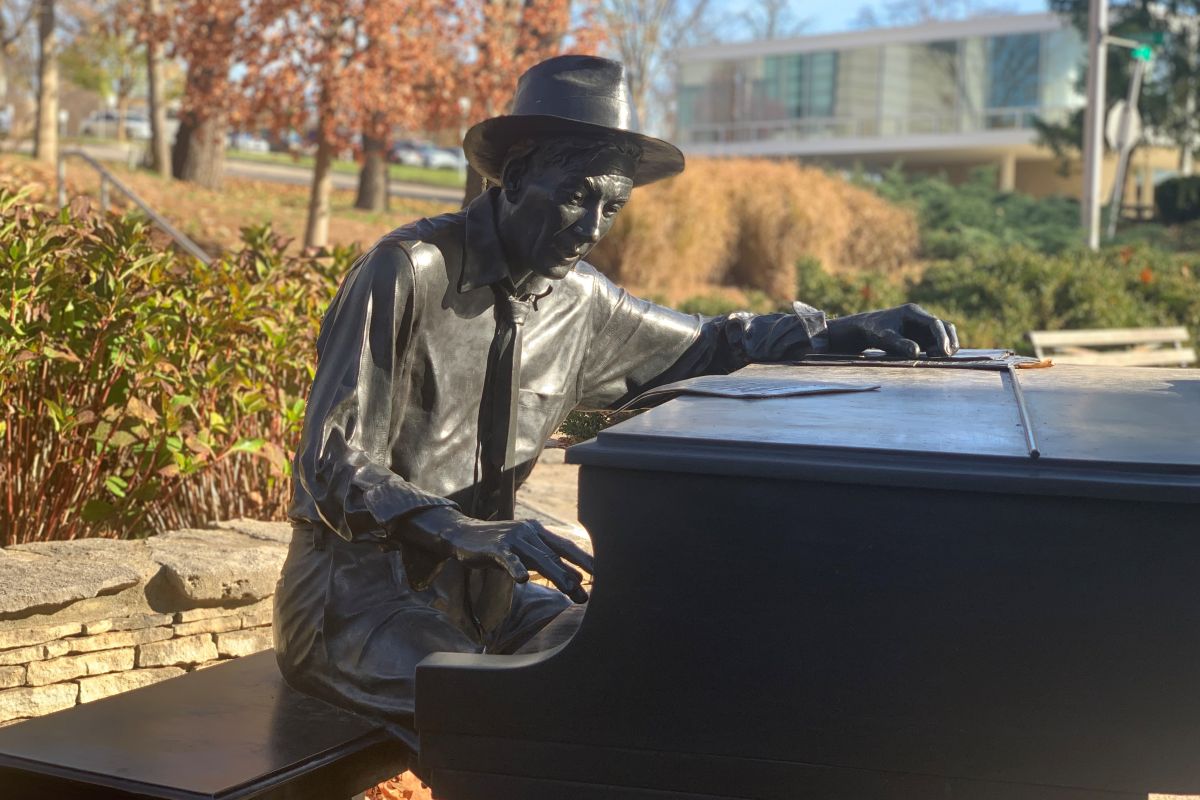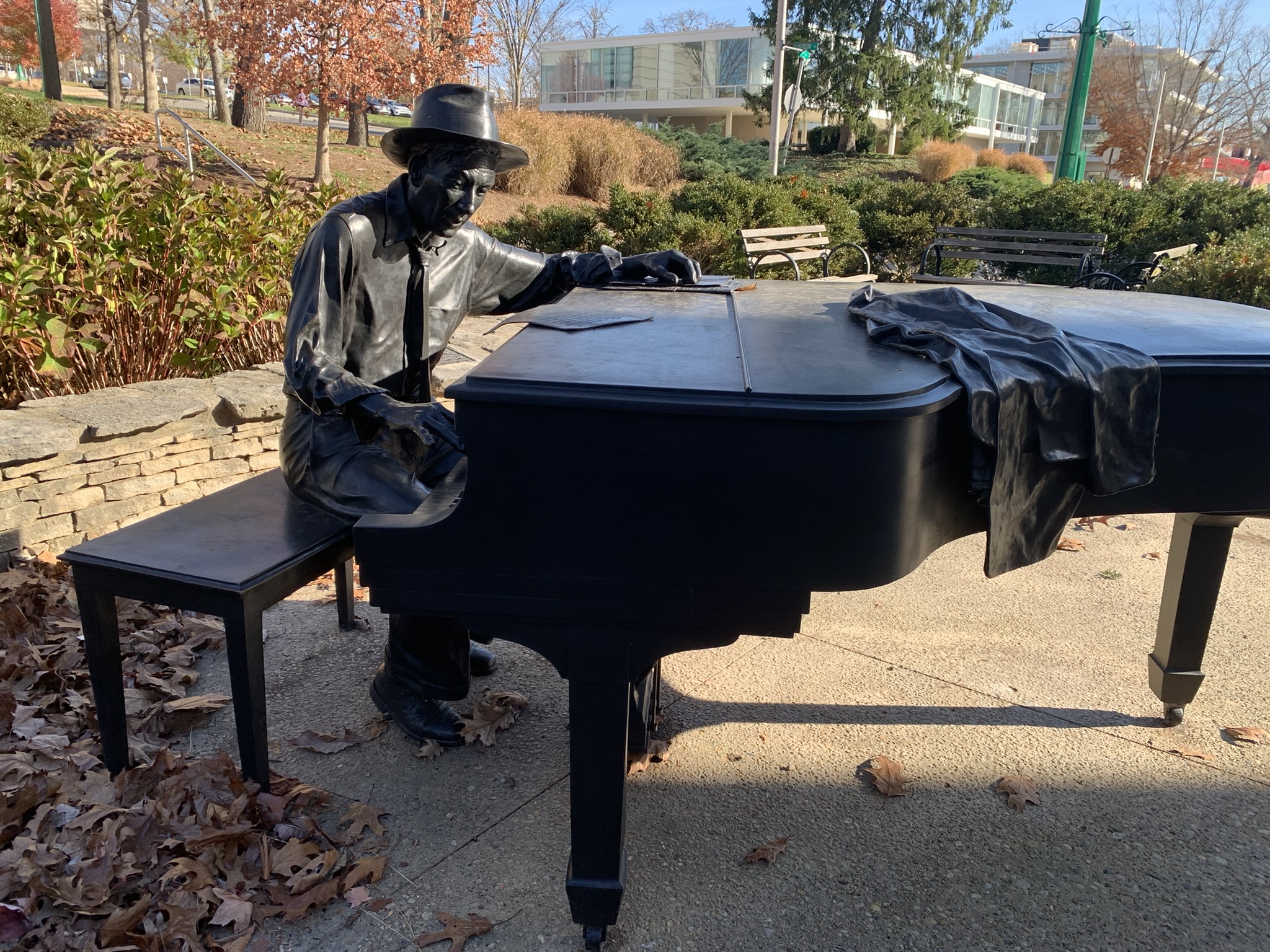MUSIC CLIP - OSCAR PETERSON, “MOONGLOW”
Welcome to Afterglow, [a show of vocal jazz and popular song from the Great American Songbook], I’m your host, Mark Chilla.
On this program, we’re paying tribute to songwriter and jazz legend Hoagy Carmichael, [for his birthday on November 22nd]. Carmichael, born in Bloomington, Indiana, became one of the most beloved entertainers of the early 20th century, and also wrote some of the most beloved American songs like “The Nearness of You,” “Skylark,” and “Georgia On My Mind.” This hour, we’ll sample from his songbook, hearing those songs performed by Frank Sinatra, Carmen McRae, Norah Jones, and more.
It’s Star Dust: The Hoagy Carmichael Songbook, coming up next on Afterglow
MUSIC - LOUIS ARMSTRONG, “LAZY RIVER”
Louis Armstrong live at the Newport Jazz Festival in 1957 with “Lazy River,” written in 1930 by New Orleans clarinetist Sidney Arodin and songwriter Hoagy Carmichael.
MUSIC CLIP - ARTIE SHAW & HIS ORCHESTRA, “STAR DUST”
Mark Chilla here on Afterglow. This hour, we’re exploring some of the best entries in the Hoagy Carmichael songbook.
We’ll start with a song that he wrote in his hometown of Bloomington, Indiana, just a few blocks from the WFIU studios where I’m recording this episode. It was his first major song, and has since gone on to become his most famous and most widely recorded song, despite the complexity of its melody and harmony. There are over 1000 versions of this song in existence.
Of course, I’m talking about “Stardust.” The legendary story of “Stardust”’s genesis goes that Hoagy was walking around Indiana University’s campus one night in 1927, looking up at the starry sky and thinking about a past love, when the melody came to him. He stepped into the downtown coffee house known as “The Book Nook,” sat down at the piano inside, and out came this song. The reality is, according to biographer Richard Sudhalter, he had probably been tinkering with the melody for a year or so. And the title “Star Dust” was dreamt up by his pal Stu Gorrell, not necessarily inspired by Hoagy’s own glances skyward.
It’s an instrumental melody—intricate and serpentine—and although Carmichael tried his hand at some lyrics early on, he ultimately didn’t think of it as a love song with words. However in 1929, publisher Irving Mills asked lyricist Mitchell Parish to pen some lyrics to “Stardust,” which became the song we know today.
It’s been a standard among vocalists since it was first performed in recordings by both Bing Crosby and Louis Armstrong back in 1931. Let’s hear a popular version from 1940 now.
This is the Tommy Dorsey Orchestra featuring Frank Sinatra and the Pied Pipers, with Hoagy Carmichael’s “Stardust,” on Afterglow.
MUSIC - TOMMY DORSEY AND HIS ORCHESTRA, WITH FRANK SINATRA AND THE PIED PIPERS, “STARDUST”
MUSIC - BILLIE HOLIDAY, “GEORGIA ON MY MIND”
Two early songs written by Hoagy Carmichael. Just now, we heard “Georgia On My Mind,” written in 1930 by Carmichael with lyrics by his close friend Stu Gorrell. That was performed by Billie Holiday in 1941. Before that, Carmichael’s enduring standard “Stardust,” whose title was created by Gorrell, but whose lyrics were written by Mitchell Parish. That was performed by Frank Sinatra and the Pied Pipers along with Tommy Dorsey and His Orchestra in 1941.
Hoagy Carmichael worked with many lyricsts over the years. In the 1930s, he had landed a job at the film studio Paramount as a staff songwriter, and the studio would often assign him a staff lyricist to work with. In 1938, that lyricist was a man by the name of Frank Loesser, who later went on to become a notable composer in his own right, penning things like the musical Guys and Dolls. As a duo, Hoagy and Frank only wrote a few songs, but they have gone on to become enduring classics. Let’s hear two now.
Here is Mel Tormé in 1951 with the most enduring song by the duo of Hoagy Carmichael and Frank Loesser, “Heart and Soul,” on Afterglow.
MUSIC - MEL TORME, “HEART AND SOUL”
MUSIC - JULIE LONDON, “TWO SLEEPY PEOPLE”
Two standards from 1938 written by Hoagy Carmichael and lyricist Frank Loesser. Just now, we heard Julie London in 1959 with “Two Sleepy People,” first sung by Bob Hope and Shirley Ross in the film The Big Broadcast of 1938. Before that, the song “Heart And Soul,” performed there by Mel Tormé for Capitol Records in 1951.
Even though the majority of Hoagy Carmichael’s songs were written in the first half of the 20th-century, his songs still continue to be performed today. I’m going to play now a few versions from here in the 21st century.
This first one comes from singer Kurt Elling, from his 2001 album Flirting With Twilight. The song is a curious one in Carmichael’s catalog, “I Get Along Without You Very Well,” a lovely tune about the attempt at perseverance after a broken heart. Carmichael based the song off of a poem he read in Life magazine titled “Except Sometimes,” written by a mysterious author who went by the initials J.B. He reworked their poem into this song. However, when he went to publish it, he couldn’t, because J.B. still had the copyright on the original poem, and no one knew where to find that person.
The call went out on Walter Winchell’s radio show, and weeks later, J.B. was found. The mysterious poet was Mrs. Jane Brown Thompson, a 71-year-old woman living in Philadelphia, who was also in poor health at the time. The copyright was worked out, but it’s very likely that Thompson passed away before she heard it performed on the radio in 1939.
Here’s that song now. This is Kurt Elling with “I Get Along Without You Very Well,” on Afterglow.
MUSIC - KURT ELLING, “I GET ALONG WITHOUT YOU VERY WELL”
MUSIC - NORAH JONES, “THE NEARNESS OF YOU”
Norah Jones, from her 2002 album Come Away With Me, and the 1937 Hoagy Carmichael and Ned Washington song “The Nearness of You.” Before that, we heard Kurt Elling in 2001, with the 1939 Hoagy Carmichael and Jane Brown Thompson song “I Get Along Without You Very Well.”
MUSIC CLIP - MILT JACKSON, “THE NEARNESS OF YOU”
We’ll hear more of the Hoagy Carmichael songbook in just a bit, stay with us.
I’m Mark Chilla, and you’re listening to Afterglow
MUSIC CLIP - OSCAR PETERSON, “I GET ALONG WITHOUT YOU VERY WELL“
MUSIC CLIP - ANDRÉ PREVIN, “SKYLARK”
Welcome back to Afterglow, I’m Mark Chilla. We’ve been sampling from the Hoagy Carmichael songbook this hour. Carmichael’s birthday is on November 22nd.
As we’ve discussed so far, Carmichael was an excellent composer and occasional lyricist, more often working with wordsmiths like Ned Washington or Frank Loesser. One of his most celebrated collaborators was a fellow singer–songwriter Johnny Mercer. Mercer was 10 years younger than Carmichael, but they each had an easy-going charm, and being from Georgia and Indiana (respectively) they had a more folksy approach to songwriting than many of the more urbane songwriters working in Tin Pan Alley.
They first teamed up in 1933, and worked together several times over the decades. In 1941, Carmichael gave Mercer a melody he had on hand called “Bix Lix,” named after his old friend, trumpeter Bix Beiderbecke. Together, Carmichael and Mercer crafted that melody into a song, known today as “Skylark.”
Let’s hear it now. This is Carmen McRae with Hoagy Carmichael and Johnny Mercer’s “Skylark,” on Afterglow.
MUSIC - CARMEN MCRAE, “SKYLARK”
MUSIC - DEAN MARTIN, “IN THE COOL, COOL, COOL OF THE EVENING”
Two songs by Hoagy Carmichael and lyricist Johnny Mercer. Just now, we heard Dean Martin in 1951 with “In The Cool, Cool, Cool of the Evening.” That song was originally intended to be in an unproduced Betty Hutton film in 1959, but later reworked into the Bing Crosby film Here Comes The Groom in 1951, and later won an Academy Award for Best Original Song. Before that, we heard their celebrated song “Skylark,” written in 1941, and performed there in 1959 by singer Carmen McRae.
While Hoagy Carmichael’s songs became fixtures in Hollywood in the 1930s, by the 1940s, the man himself also became a fixture on screen as an actor. His first main role was in the 1944 Humphrey Bogart and Lauren Bacall film To Have And Have Not, where he played the role of Cricket, the piano player. Carmichael plays a few of his original songs in the film, and others were used as background music, including this next one, “Baltimore Oriole.”
The lyrics here are by one of his great collaborators, Paul Francis Webster, who understood Carmichael’s folksy charm. The melody is bluesy, inspired in part by Jewish cantor melodies, although it was deemed too difficult for Lauren Bacall to sing in the film, which is why it ended up as background music.
Nevertheless, here it is, sung by Barbara Lea in 1957. This is Hoagy Carmichael’s “Baltimore Oriole,” on Afterglow.
MUSIC - BARBARA LEA, “BALTIMORE ORIOLE”
MUSIC - TEDDI KING, “NEW ORLEANS”
Singer Teddi King in 1954 with Hoagy Carmichael’s “New Orleans,” one of the few songs where he wrote both melody and words. Before that, we heard Barbara Lea, one of Carmichael’s champions, in1957 singing “Baltimore Oriole,” a song written in 1944 with lyricist Paul Francis Webster.
There are entries in the Hoagy Carmichael songbook that are somewhat problematic here in the 21st century. For instance, I don’t feel entirely comfortable playing songs like “Hong Kong Blues” or “Doctor, Lawyer, Indian Chief,” with the stereotypes that they portray. And even beloved songs like “Rockin’ Chair” and “Lazybones,” as catchy as they are, are inspired by racist minstrel tropes. A common occurrence in pop tunes from the late 1920s and early 1930s, but unacceptable a century later.
Even on this next song I’ll play, it teeters on the edge of acceptability. Here, it’s not the racial politics that are the issue, but rather the sexual politics. And it’s not that they are offensive, per se, but rather, they’re just a bit old fashioned. The dated lyrics here are by Harold Adamson, but Carmichael’s melody is timeless and infectious. Plus the performance is sublime.
Here is singer Kay Starr in 1950 with Hoagy Carmichael and Harold Adamson’s “A Woman Likes To Be Told,” on Afterglow.
MUSIC - KAY STARR, “A WOMAN LIKES TO BE TOLD”
Kay Starr with an instruction manual for clueless 1940s bachelors. That was Hoagy Carmichael and Harold Adamson’s “A Woman Likes To Be Told.”
To close off this episode on Hoagy Carmichael’s songs, I want to feature a performance from the man himself. Hoagy is often considered to be one of the original “singer-songwriters” in American pop music, possessed of a charming, if untrained voice.
Right outside of our radio studio here at WFIU, in Hoagy Carmichael’s hometown of Bloomington, Indiana, sits a statue of the gentleman. I pass by it everyday, and you’ll often find someone has placed freshly picked flowers in one of his hands. The statue is lifesize and incredibly lifelike: a gaunt, but handsome figure sitting at a full-size Steinway Grand Piano cast in bronze. Donning a porkpie hat, with his sportcoat strewn onto the piano frame, Hoagy is permanently tinkling away at his original tune “Memphis In June,” the sheet music sitting in front of him.
And with that, here is Hoagy Carmichael himself, from the 1956 album Hoagy Sings Carmichael with “Memphis In June,” on Afterglow.
MUSIC - HOAGY CARMICHAEL, “MEMPHIS IN JUNE”
Hoagy Carmichael in 1956, performing his own song “Memphis In June,” with lyrics by Paul Francis Webster.
Thanks for tuning in to this Hoagy Carmichael songbook edition of Afterglow.
MUSIC CLIP - LESTER YOUNG WITH THE OSCAR PETERSON TRIO, “STARDUST”











